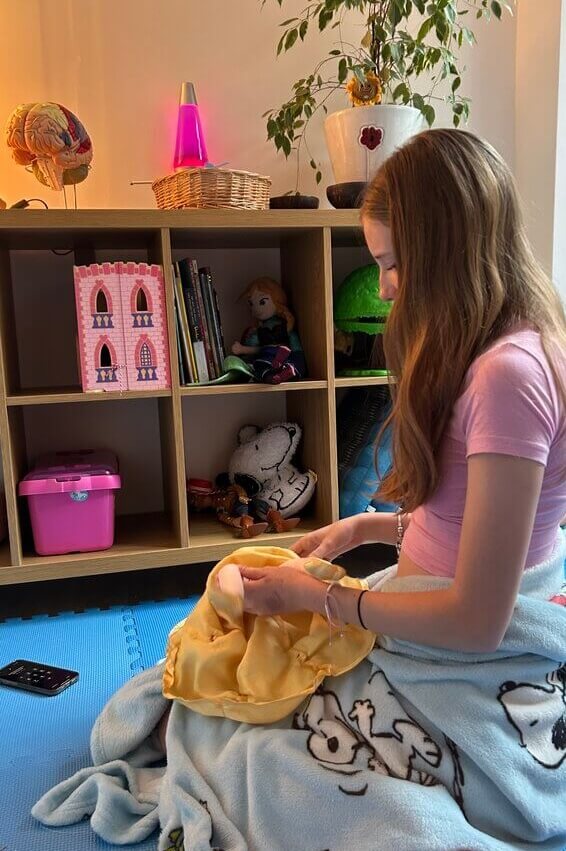What Is Play Therapy?
At its heart, play therapy offers children a safe and creative space to explore their emotions, tell their stories, and grow through a therapeutic relationship built on trust, attunement, and unconditional acceptance.

An Experience, Not a Definition
It has taken me a long time to begin to answer this question—and even longer to feel that my answer is truly authentic.
I could quote books and experts who attempt to define play therapy, but even their words often fall short of conveying the felt sense of what it really is. Because play therapy is not easily captured in a definition—it’s an experience, a relationship, a process.
Meeting the Child Where They Are
At its core, play therapy is a space where the therapist meets the child in an environment designed to offer the optimum conditions for healing and growth. Many children—and adults, too—find it difficult to express themselves through words. It’s easy to say, “I’m fine,” or to hide behind surface-level conversation. Play, however, allows children to communicate their inner world in the way that feels most natural to them.
The Child Leads, The Therapist Holds
Play therapy is a dynamic, creative process led by the child’s own needs and feelings. The therapist provides a safe container—holding and witnessing the child’s expression, and responding with empathy and understanding. In the playroom, toys and resources come alive with emotion. Children naturally express their deepest drives, worries, fears, anger, sadness, and confusion through play. They tell stories in role play, re-enact scenes with intensity, and often bring parts of themselves into the open—parts they may not yet be ready to speak about.
Every therapeutic relationship is unique. No two play therapy journeys are the same. What remains consistent, however, is the unconditional positive regard the therapist holds for the child—an unwavering acceptance of all their emotions and experiences. It is this, combined with a deep attunement to the child’s world, that fosters healing and growth.
The Many Forms Play Can Take
Sessions vary in pace—some are quiet and slow, others are energetic and full of action. The playroom holds many tools to support emotional expression. Children often gravitate toward sensory materials like sand or water to soothe and regulate. Others prefer imaginative play, symbolic storytelling, or aggressive, high-energy activities that offer release and meaning.
A Space Unlike Home or School
There are few rules in the playroom. I make it clear that this space is different from home or school. For example, there is no expectation to tidy up. In fact, leaving the mess behind can be therapeutic in itself—a symbolic handing over of emotional weight to be held by the therapist. After the child leaves, I often take time to reflect, to make sense of what was communicated through their play. What am I left with? What did I feel?
Holding the Child's Emotional World
Sometimes, I find myself holding the child’s emotional projections. I may suddenly feel sadness, anger, or confusion—emotions that aren’t my own. I hold them gently, wondering what the child is asking me to feel, to witness, or to help carry.
Change Unfolds at the Child's Pace
Change can come slowly or all at once, and the pace often fluctuates. In review meetings, parents are sometimes surprised by how much has shifted. Change in play therapy is not linear—but it is deep, often showing up in subtle, powerful ways.
The Heart of the Work: Relationship
The therapeutic relationship is the heart of the work. Without it, no real change can occur. The child must feel safe, seen, heard, and accepted—not just for their “best” parts, but also for the parts they may struggle to like or understand. Over time, we explore these parts together—tentatively at first, then more openly, as the child is ready.
A Process Both Structured and Intuitive
There are no concrete answers or fixed paths in play therapy. For me, it’s a structured yet intuitive process, deeply rooted in theory and research, but also filled with spontaneity, creativity, and beauty. I consider it a privilege to work with the children and young people who come into my playroom. Every day, I witness extraordinary courage, resilience, and imagination. I sit with their pain, their joy, their delight, and their despair—and through our connection, we learn how to bear it together.
What Is Play Therapy?
So, what is play therapy?
It is a unique, child-centred, child-led process. The child sets the pace and direction. The therapist listens, responds, and attunes—much like a caregiver does with an infant—naming emotions, holding space, and gently guiding when needed.
When a child is ready to leave therapy, there is often a felt sense that they have been held, thought about, and unconditionally accepted. Many leave with renewed energy, greater confidence, and a deeper sense of self. Often, it feels as if a “heaviness” has lifted, and they are ready to re-engage with life, to flourish.
In my heart, I carry a sparkly, colourful gem for every child I’ve worked with—each one unique, cherished, and deeply special.
Play therapy is more than a therapeutic model. It is a way of being—creative, flexible, and full of meaning. It offers lifelong tools, not only for the child, but for all who are touched by it.